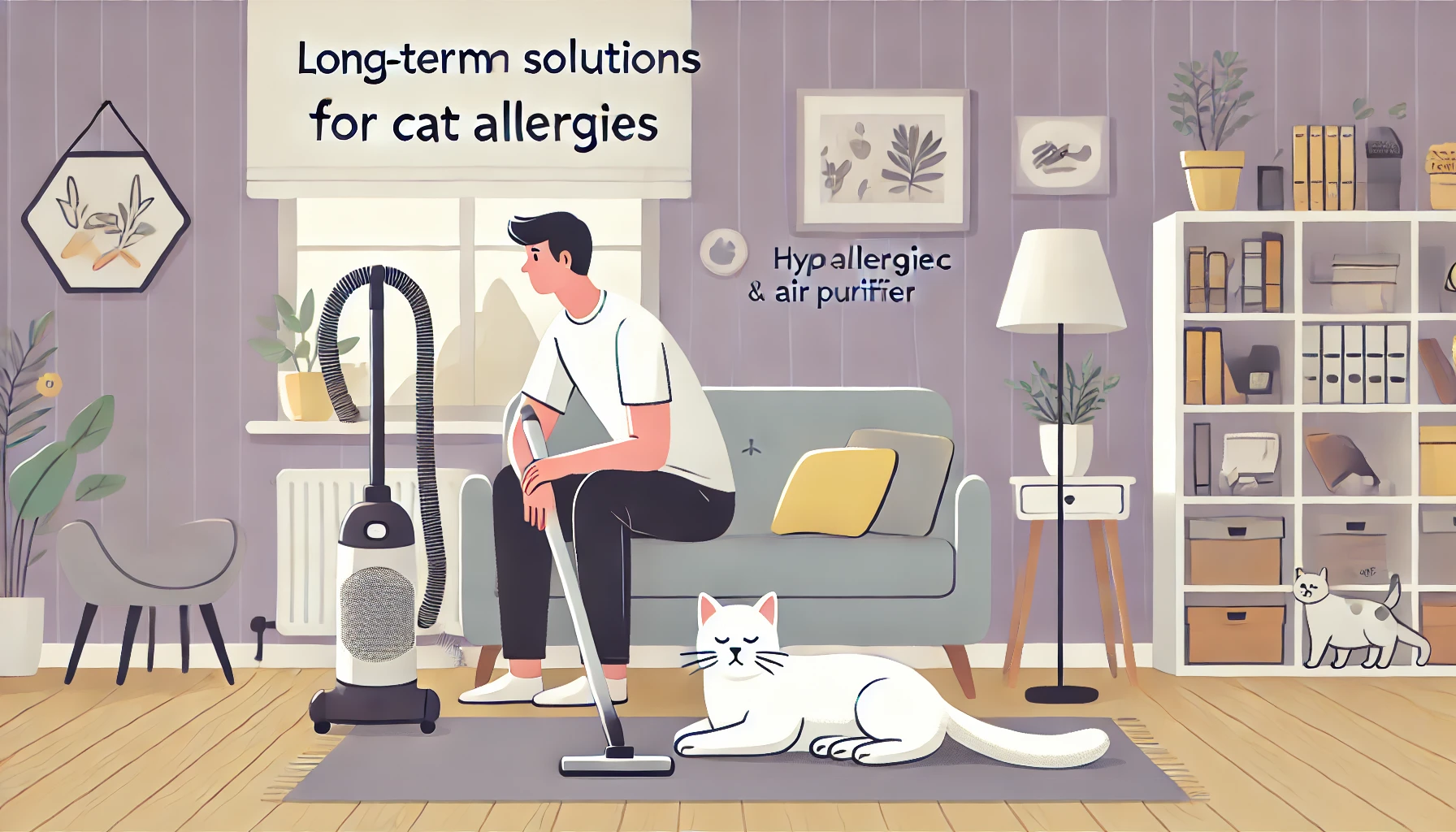How to Address Cat Allergies and Symptoms Effectively

Cats are amazing companions, but to a huge number of people, being around these furry friends quickly turns into sudden fits of sneezing, itchy eyes, or something even worse.
For those truly fond of cats who often show allergic reactions to them, cat allergies may be a huge stumbling block to really enjoying the company of these endearing animals.
Knowing and understanding cat allergies is important for any person who already owns a cat or is thinking of bringing one home, so that they can live in harmony with their pet.
This article can help you cope effectively with feline allergies, from the beginning of noticing symptoms to the adoption of methods for their minimization.
Living with cat allergies does not necessarily mean you have to get rid of your pet or live in discomfort.
Once properly equipped, you are able to reduce allergens in the home and minimize the effects of cat allergies.
Let’s begin by looking at what causes reactions and identifying some triggers that may be affecting you or your family.
Table of Contents
Understanding Cat Allergies: Causes and Triggers
In cat allergies, it is not the fur of the cat that causes most reactions.
Actually, the biggest part of allergic reactions is caused by proteins found in a cat’s saliva, urine, and dander (dead skin flakes).
These proteins become airborne and can attach themselves to furniture, carpets, clothes, or even your skin.
Once they are inhaled or touched, they cause an overreaction of the immune system, leading to symptoms such as sneezing, itching, and congestion—all typical symptoms of cat allergies.
Certain specific triggers may cause cat allergies to flare up or become more apparent.
These include the following:
- Cat dander: Minute particles of a cat’s dead skin that spread throughout the home and stick to almost everything, stirring allergic responses in sensitive people.
- Saliva: Cats frequently groom themselves, spreading allergenic proteins all over their fur. Later, when you stroke your cat, these proteins come into contact with your hands or surroundings.
- Urine: The proteins are also present in a cat’s urine, which may cause allergic reactions, especially when cleaning the litter box or when you are around it.
Cat fur can also hold allergens such as pollen, dust, and mold.
These allergens, when in contact with the fur, can become airborne and build up, causing further allergic reactions.
Even short-haired or hairless cats can trigger a reaction because it is not the length of the hair, but the proteins that matter.
Allergic reactions to cats vary in everyone, from mild discomfort to serious symptoms that require a consultation with a doctor.
The key to managing cat allergies is first to understand what triggers the reaction.
Understanding the root causes of cat allergies helps in managing them better.

How to Recognize the Symptoms of Cat Allergies in People
Symptoms of cat allergies may be really hard to recognize since most of them resemble other common allergies or certain respiratory issues.
However, knowing these symptoms will give you a fair idea if your cat may be the one causing you distress.
It is also important to recognize them early because continuous exposure to cat allergens can increase symptom severity over time.

Common Cat Allergy Symptoms
Cat allergy symptoms can be mild or severe, and they manifest in many ways.
Here are some common signs:
- Respiratory problems: These are usually characterized by sneezing, coughing, and shortness of breath, which are typical reactions to cat allergens. Many individuals experience these symptoms when exposed to cat dander.
- Itchy or watery eyes: Irritated eyes are among the more standard responses to cat allergens. These may turn red, swell, and water, even within minutes of contact with cats.
- Skin reactions: Some people develop rashes, hives, or itching sensations at the point of contact after touching cats or being in areas where cats shed dander.
- Nasal congestion: A stuffy or runny nose may be one of the more obvious signs of cat allergies. This can be accompanied by sinus pressure or headaches.
- Asthma flare-ups: Cat allergens can trigger or increase asthma symptoms in people with asthma, including wheezing and shortness of breath.

Severe Cat Allergy Reactions
Although rare, some individuals with cat allergies may experience more severe reactions.
Anaphylaxis, a life-threatening allergic response, can occur, especially in people with a history of severe allergies.
Symptoms may include swelling of the throat, difficulty breathing, and a sudden drop in blood pressure.
If any of these symptoms appear after exposure to cats, seek medical attention immediately.

How to Differentiate Symptoms of Cat Allergies from Other Types of Allergies
While many allergic reactions overlap symptomatically, it can be difficult to determine if cats are the trigger.
If you notice symptoms specifically when around cats or after being in places where cats have been, it is very likely a feline allergy.
You can also visit an allergist who will perform tests, such as skin prick tests and blood tests, to identify specific allergens like cat dander and confirm your diagnosis.
Keep in mind that cat allergy symptoms can be seasonal or triggered by other allergens like dust, mold, or pollen that may also be present in a home with a cat.
By paying attention to the time and place your symptoms occur, you can better identify if cats are indeed the cause.
Identifying symptoms early can prevent more severe allergic reactions over time.

Effective Treatments for Cat Allergies
Dealing with cat allergies does not mean you have to part ways with your beloved pet.
There are numerous treatments available for reducing the symptoms, allowing you to coexist peacefully with your cat.
From medications to natural remedies, you can choose the best treatment that suits your lifestyle and the severity of your allergic reactions.

Over-the-Counter Remedies for Cat Allergies
Mild to moderate cat allergy symptoms can see substantial relief from OTC medications.
Antihistamines, such as cetirizine, loratadine, or diphenhydramine, work by blocking histamines—chemicals your body produces during an allergic reaction—and help reduce sneezing, itching, and nasal congestion.
Decongestants like pseudoephedrine can also help relieve nasal congestion and sinus pressure.
In addition, nasal corticosteroid sprays can reduce inflammation within the nasal passages and help with other symptoms, such as runny noses and sneezing.
Eye drops, especially those designed for allergy relief, can soothe red, itchy eyes caused by cat allergens.

Prescription Medications for Severe Allergies
If over-the-counter remedies are not strong enough to control your cat allergy symptoms, your doctor may suggest prescription medications.
Stronger antihistamines, corticosteroids, and leukotriene modifiers, including montelukast, can help in more serious cases.
Allergy shots, otherwise known as immunotherapy, are also an option.
These shots gradually expose your body to the cat allergen over time, allowing the immune system to build tolerance and reduce allergic reactions in the long run.

Other Treatment Approaches: Complementary Medicines and Lifestyle Modifications
For those looking for a more natural way to manage cat allergies, complementary medicines and lifestyle changes can be quite effective.
Regular cleaning, vacuuming, and air purification can significantly reduce the allergen load in your home.
HEPA filters in air purifiers and vacuum cleaners can trap even the smallest particles of cat dander and other allergens.
- Bathing: Bathing your cat can reduce the amount of dander and saliva on its fur. While not all cats tolerate bathing, it can make a noticeable difference for allergy sufferers.
- Allergy-free zones: Creating allergy-free zones in your home, such as keeping your cat out of the bedroom, can provide relief, especially at night when symptoms might worsen.
- Hygiene practices: Washing your hands after petting your cat and changing clothes afterward can also reduce the transfer of allergens.
Alternative remedies like quercetin, a plant flavonoid with anti-inflammatory properties, and butterbur, a herb that acts as a natural antihistamine, have shown relief for some allergy sufferers.
Always consult a healthcare professional before trying new treatments to ensure they are safe and effective for your specific needs.
There are many treatment options available to manage cat allergy symptoms.

Cat Allergies Home Prevention
Preventing cat allergies does not have to mean removing your cats entirely.
By taking the right steps, you can make your home environment much more allergy-friendly and significantly reduce the allergens that trigger reactions.
A good cleaning routine, home adjustments, and using the right tools can make your space much more comfortable for allergy sufferers.

How to Minimize Allergens within the Home
You can reduce the amount of allergens in your living environment by following these feasible practices:
- Vacuuming: Regularly vacuum your home, especially in areas where your cat spends the most time, to remove dander and hair that contain allergens. Use a vacuum cleaner with a HEPA filter because it catches the smallest particles.
- Cleaning surfaces: Dust and wipe down hard surfaces such as cabinets, tables, and furniture, as allergens accumulate on these surfaces easily. It’s also a good idea to wash bedding, curtains, and other fabric surfaces regularly.
- Air purification: Air purifiers with HEPA filters can significantly reduce airborne allergens. Run air purifiers continuously, especially in common areas and bedrooms, to improve air quality for allergy sufferers.

Tips for Cleaning and Maintenance for Allergy Sufferers
Keeping your home clean is a key factor in controlling cat allergies.
In addition to vacuuming and dusting, here are some essential cleaning practices:
- Washing your cat’s bedding regularly: Dander easily collects on your cat’s favorite resting spots, so wash their bedding weekly in hot water to prevent the build-up of allergens.
- Grooming your cat regularly: Regular brushing of your cat, preferably outdoors, helps remove loose fur and dander before they spread throughout your home. Grooming wipes are also available to reduce allergens.
- Maintain humidity: Keeping your home’s humidity between 30-50% prevents allergens from sticking to surfaces and reduces mold growth, which can further trigger allergic responses.

How Air Purifiers and Filters Help with Cat Allergies
Air purifiers can be a lifesaver for those with cat allergies.
These devices filter out airborne allergens like cat dander, dust, and pollen.
For maximum efficiency, use an air purifier with a HEPA filter, designed to capture particles as small as 0.3 microns, including cat allergens.
Place your air purifier in the room where you spend the most time, such as the bedroom or living room.
Running it continuously can help keep allergens minimized.
For even better results, combine the use of air purifiers with regular vacuuming and dusting.
By adopting the right cleaning techniques and forming good habits, you can significantly reduce cat allergens in your home, making it more comfortable for both you and your feline friend.
Failing to maintain a clean home environment may worsen cat allergies.

Cats: How to Live with Them If You Have Allergies, Practical Advice
For people who love cats, the idea of living without them might seem heartbreaking.
Fortunately, you can live with cats even if you have cat allergies—you just need to take the necessary precautions.
By picking the right breed, building up your allergy tolerance, and creating an allergy-friendly home environment, you can minimize the impact of cat allergies and enjoy your feline companion.

Picking Hypoallergenic Cat Breeds
While no cat breed is truly hypoallergenic, some produce fewer allergens than others and are therefore easier for people with cat allergies to tolerate.
Hypoallergenic breeds tend to produce less of the Fel d 1 protein, which is the main allergenic protein in cats.
- Siberians: Many have been reported to produce fewer Fel d 1 proteins and are often recommended for those with allergies.
- Balinese: These cats, also known as the ‘long-haired Siamese,’ are often less allergenic despite their long fur.
- Devon Rex and Cornish Rex: Both varieties have shorter, wavy coats, which limits the amount of dander they shed.
- Sphynx cats: These hairless cats still produce dander, but allergens can be more easily managed through regular grooming.

Building Up Allergy Resistance Over Time
Over time, some people’s bodies become accustomed to living with a cat, and their allergic reactions may reduce.
This is because repeated exposure to allergens can sometimes teach the immune system to tolerate them.
However, this doesn’t happen for everyone, and it’s important to monitor your symptoms closely if you’re trying to build resistance.
Below are a few strategies that can help increase your tolerance over time:
- Gradual exposure: Allow your body to adjust by gradually increasing the time you spend with your cat each day, especially if you’ve just adopted one.
- Regular cleaning: Clean your home and groom your cat regularly to limit the amount of allergens present, making it easier for your immune system to handle.
- Medical support: Speak with your doctor about allergy shots or medications that may help your body adjust better to cat allergens over time.

Creating an Allergy-Friendly Space
If you have cat allergies, it’s important to create a space where you and your cat can both be comfortable.
By making a few changes, you can make your home more hypoallergenic and improve your quality of life:
- Set aside areas in your home as cat-free zones: Keeping your cat out of certain rooms, like your bedroom, can give you a sanctuary from allergens, especially at night.
- Allergen-resistant bedding: Certain bedding materials are designed to prevent the accumulation of allergens, helping you stay more comfortable during the night.
- HEPA filters: Use air purifiers with HEPA filters in key areas of your home to filter out airborne allergens and improve air quality.
- Grooming and hygiene: Regularly bathing and brushing your cat can reduce the amount of dander and allergens they shed into the environment.
Living with cat allergies doesn’t mean you have to part ways with your furry companion.
By taking the right steps, you can manage your symptoms and enjoy the companionship of your cat.
Living with cats despite allergies is possible with the right lifestyle adjustments.

Conclusion: Managing Cat Allergies Effectively
While having allergies to cats might seem challenging, there are ways to enjoy the company of your feline friend while preventing any worsening of your condition.
By understanding the causes and triggers of cat allergies, recognizing symptoms, and exploring the various treatment options available, you can manage your allergic reactions without needing to part ways with your cat.

Living with Cat Allergies: Key Takeaways
The following key points summarize the most effective strategies for reducing and managing cat allergies:
- Identify triggers: Knowing what triggers your cat allergies—whether it’s dander, saliva, or urine—is crucial for symptom management.
- Choose the right breed: Although no breed is completely hypoallergenic, some cats produce fewer allergens than others, making them a good choice for allergy sufferers.
- Consider over-the-counter and prescription treatments: Antihistamines, decongestants, and allergy shots are all viable options for controlling allergic reactions. Research which option works best for you.
- Clean and create a comfortable home: Regular cleaning, air purification, and grooming can significantly reduce allergens, making your living space more comfortable for both you and your cat.

Long-Term Solutions for Cat Allergy Sufferers
Managing cat allergies effectively requires a combination of short- and long-term strategies.
In addition to daily cleaning and medication, lifestyle changes—such as establishing cat-free zones and using allergen-resistant materials—can make a huge difference.
Some people also find that their bodies develop resistance to cat allergens over time.
Gradual exposure and medical treatments like immunotherapy can help build tolerance, making it easier to live with cats.
With the right tools and support, managing cat allergies doesn’t have to be an impossible task.
By incorporating these steps into your daily routine, you can reduce your symptoms and maintain a happy, healthy relationship with your cat.
The right approach allows you to live with cat allergies while still enjoying the joys of being a cat owner.
With a proactive approach, cat allergies can be managed while enjoying your cat’s company.

Cat Allergy Frequently Asked Questions
If you have cat allergies or are concerned about managing cat allergies while living with a cat, this section answers common questions.
These answers will help you better understand how to reduce symptoms and live comfortably with your cat.
Can you build up an immunity to cat allergies over time?
In some cases, repeated exposure to allergens can help the immune system develop a form of tolerance.
However, this doesn’t work for everyone, and it’s important to monitor symptoms and seek medical advice if needed.
What is the main cause of cat allergies?
Cat allergies are primarily caused by proteins found in a cat’s saliva, urine, and dander.
When these proteins become airborne and are inhaled or come into contact with the skin, allergic reactions can occur.
Are hypoallergenic cat breeds completely allergen-free?
No cat breed is entirely hypoallergenic, but some produce fewer allergens.
Breeds like Siberians, Balinese, and Devon Rex tend to produce less of the Fel d 1 protein, making them better for allergy sufferers.
Can air purifiers help reduce the allergens from cats in a home?
Yes, air purifiers with HEPA filters can help remove airborne allergens such as cat dander and dust.
This can improve air quality, especially in key areas where you and your cat spend most of your time.






That is quite an informative, helpful article in understanding how to reduce allergens and what the treatment options available are. Learning how to manage allergies to cats will definitely help us live far more comfortably with our fur babies. Thanks for sharing great information!